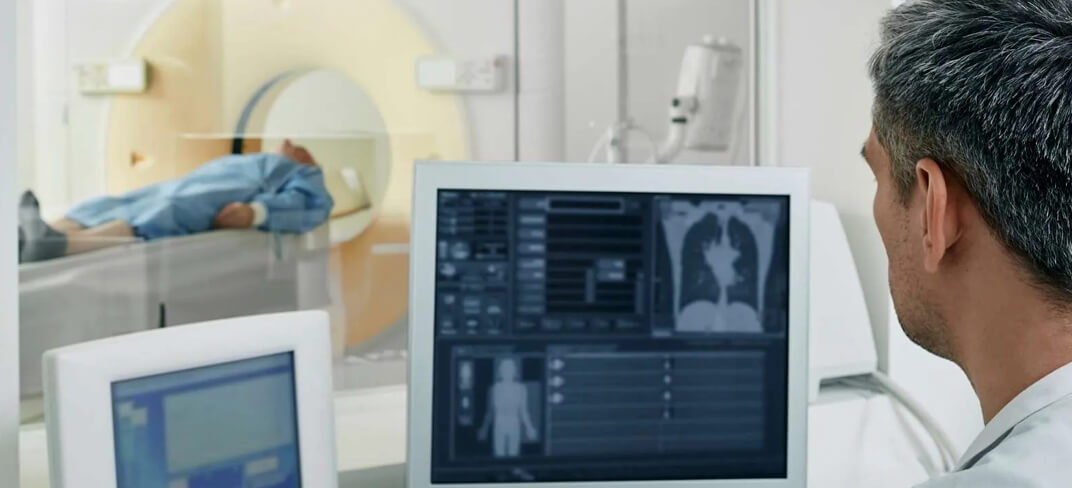Lung Cancer: CT Scan for Prevention. Interview with Dr. Paciucci

28 July 2025
Today lung cancer is one of the leading causes of tumor-related death. Also, it's among the cancers with the highest incidence rates. In 2024, there were an estimated 44,831 new cases of lung cancer: 31,891 in men and 12,940 in women (source: “I numeri del cancro in Italia 2024, AIOM- AIRTUM).
These figures serve as a strong reminder of the importance of primary prevention. Quitting smoking is the first and most crucial step to reduce the risk of developing this disease. However, secondary prevention is equally important. Thanks to advances in screening techniques, it is now possible to detect lung cancer at an early stage, strongly improving chances of recovery and also survival rates. Low-dose CT scan screening is proving to be one of the most effective tools for this purpose. We discussed this topic with Dr. Leonardo Paciucci, radiodiagnostic specialist at UPMC Salvator Mundi International Hospital.
Dr. Paciucci, what are the current figures on lung cancer?
Today, lung cancer is the second most common tumor in terms of annual cases, associated with a very high mortality rate. When diagnosed at an advanced stage, i.e. stage III or IV, the five-year survival rate is extremely low, often less than 5%. However, when the disease is detected early, survival rates can exceed 80% in some cases. This shows the critical importance of screening, allowing for the earliest possible detection of the disease. A chest CT scan remains the most suitable and effective tool to achieving this early diagnosis.
How does it work?
Thanks to a low-dose CT scan, we are able to perform highly accurate tests without using contrast agents. Over the past fifteen years, several studies have shown that, in high-risk populations, this screening can reduce lung cancer mortality by up to 40% in women and up to 30% in men.
Who should undergo a chest CT scan for lung cancer prevention?
Studies conducted so far indicate this screening is particularly effective for smokers between the ages of 50 and 80, regardless of gender. This also includes former smokers who smoked at least one pack of cigarettes a day for 20 years and who quit less than 15 years ago. Another, smaller high-risk group includes individuals who, due to occupational or environmental exposure, have come in contact with substances that have been proven over time to be harmful and carcinogenic to the lungs.
Is the test invasive or painful? Does it involve any risks?
The test is very quick, extremely safe, and completely painless. Even a frail or vulnerable person can safely undergo it. The risks are extremely low. The main risk, as with any radiology test, is exposure to ionizing radiation. However, in this case the doses are extremely low. A second risk, if we can call it that, is the risk of overdiagnosis. Among people in the high-risk group, up to 50% may present with one or more pulmonary nodules. Fortunately, about 95% of these nodules are benign. The concern, therefore, is that patients with benign nodules might undergo unnecessary additional testing. Recently, however, this risk has significantly reduced thanks to advanced diagnostic methods that allow to clearly distinguish between high-, medium-, and low-risk nodules, and to resort to more invasive tests only when truly necessary.
What can be the potential outcomes of the test and what should be done afterwards?
Basically, there are two possible outcomes: either no abnormalities are found, or a typical pulmonary nodule is detected, which can sometimes be a precursor to lung cancer. If no nodules are found or if a low-risk nodule is detected, the patient continues his or her regular screening schedule, which is generally annual. If medium-risk nodules are identified, more frequent follow-ups can be arranged, for example, every six months. If, on the other hand, high-risk nodules are found, which fortunately represent a small percentage, the patient undergoes second-level tests, such as a PET CT scan or a lung biopsy with histological testing.
Learn more about diagnostic tests at UPMC Salvator Mundi International Hospital.